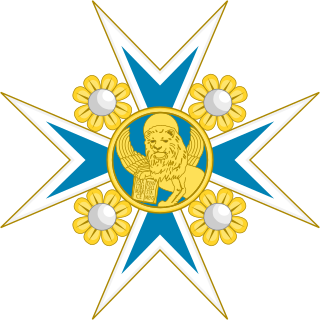Related Research Articles

The Council of Ten, or simply the Ten, was from 1310 to 1797 one of the major governing bodies of the Republic of Venice. Elections took place annually and the Council of Ten had the power to impose punishments upon nobles. The Council of Ten had a broad jurisdictional mandate over matters of state security. The Council of Ten and the Full College constituted the inner circle of oligarchical patricians who effectively ruled the Republic of Venice.

The office of Procurator of Saint Mark was one of the few lifetime appointments in the government of the Venetian Republic and was considered second only to that of the doge in prestige. It was routinely occupied by nobles belonging to the most influential families and typically represented the climax of a distinguished political career, although it was often an intermediate position prior to election as doge.

The Senate, formally the Consiglio dei Pregadi or Rogati, was the main deliberative and legislative body of the Republic of Venice.

The Minor Council or Ducal Council was one of the main constitutional bodies of the Republic of Venice, and served both as advisors and partners to the Doge of Venice, sharing and limiting his authority.

The Order of Saint Mark was the sole order of chivalry of the Republic of Venice. It was named in honour of Venice's patron saint, Mark the Evangelist.

The Venetian navy was the navy of the Venetian Republic which played an important role in the history of the republic and the Mediterranean world. It was the premier navy in the Mediterranean Sea for many centuries between the medieval and early modern periods, providing Venice with control and influence over trade and politics far in excess of the republic's size and population. It was one of the first navies to mount gunpowder weapons aboard ships, and through an organised system of naval dockyards, armouries and chandlers was able to continually keep ships at sea and rapidly replace losses. The Venetian Arsenal was one of the greatest concentrations of industrial capacity prior to the Industrial Revolution and responsible for the bulk of the republic's naval power.
The Savii or Savi del Consiglio dei Pregadi, also known as the Savi[i] Grandi, were senior magistrates of the Republic of Venice.
The Savii or Savi di Terraferma was a board of five senior magistrates of the Republic of Venice, initially charged with the defence of the Republic's possessions in the Italian mainland. Gradually they assumed specific roles pertaining to the supervision of public finances, the military administration, state ceremonies, and urgent ad hoc matters.
The Captain of the Gulf was a senior naval command of the Republic of Venice.

The Full College was the main executive body of the Republic of Venice, overseeing day-to-day governance and preparing the agenda for the Venetian Senate.

The Provveditore Generale da Mar was a senior office in the Venetian navy and in the Venetian overseas empire.

The Magistrato alla Sanità was the office of the Republic of Venice definitively instituted in 1490 to manage public health in the city of Venice and its territories, with specific attention on preventing the spread of epidemics within the maritime republic. The magistracy was among the first health authorities in Europe to institute public inoculation projects to prevent the spread of infectious diseases.

The Magistrato alle Acque was a collective magistracy of the Republic of Venice, responsible for water management in the Venetian Lagoon. It comprised a series of boards of magistrates established in the early 16th century, and existed until the Fall of the Republic of Venice in 1797. Between 1907 and 2014, the body was revived by the Italian state, with responsibilities extending over the entire Veneto and the Province of Mantua.

The Riformatori dello studio di Padova, also Riformatori allo studio di Padova, were the three officials of the Venetian Republic responsible for overseeing education and culture. Created in 1517, initially to reopen the University of Padua after the War of the League of Cambrai, they became responsible over time for public and private schooling at all levels, public libraries in Venice and Padua, intellectual academies, and professional schools. They also reviewed and authorized for publication all books within the mainland territory of Venice.
The Venetian Inquisition, formally the Holy Office, was the tribunal established jointly by the Venetian government and the Roman Catholic Church to repress heresy throughout the Republic of Venice. The inquisition also intervened in cases of sacrilege, apostasy, prohibited books, superstition, and witchcraft. It was established in the 16th-century and was abolished in 1797.
This is an alphabetical index of people, places, things, and concepts related to or originating from the Republic of Venice. Feel free to add more, and create missing pages.
The Magistrato alle Pompe was a government department of the Republic of Venice responsible for upholding the Republic's sumptuary laws.
The Provveditori all'Armar were officials of the Republic of Venice responsible for the provisioning and equipment of the ships and crews of the Venetian navy.
The Camerlenghi di Comun were senior fiscal officials of the Republic of Venice.
The Cinque Savi alla Mercanzia was a magistracy of the Republic of Venice responsible for the oversight of trade and manufacturing.
References
- ↑ Lane 1973, p. 254.
- ↑ Kohl & O'Connell 2014, p. 35.
- ↑ Kohl & O'Connell 2014, pp. 35–36.
- ↑ Da Mosto 1937, p. 22.
- ↑ Kohl & O'Connell 2014, pp. 42–44.
- 1 2 Chambers, Fletcher & Pullan 2001, p. 43.
- ↑ Finlay 1980, p. 206.
- ↑ Chambers, Fletcher & Pullan 2001, pp. 43, 44.
- ↑ Finlay 1980, p. 40.
- ↑ Brown 1887, p. 187.
